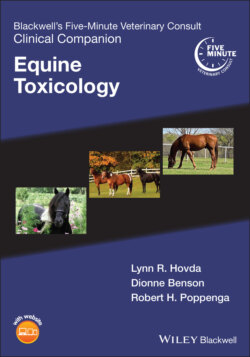Читать книгу Blackwell's Five-Minute Veterinary Consult Clinical Companion - Группа авторов - Страница 18
DIFFERENTIAL DIAGNOSIS
ОглавлениеEstablishing an accurate diagnosis depends heavily on a systematic approach because toxicants often have clinical signs that overlap with other non‐toxicologic causes and lesions may or may not be present.
Even if a poisoning is suspected, the practitioner has to be a neutral observer considering toxic as well as non‐toxic causes of disease. For example, lead poisoning may cause few or very subtle lesions while oak or monensin intoxications cause consistent lesions helpful for making a diagnosis.
The absence of lesions is as important as their presence and is helpful in narrowing down a differentials list.
An accurate diagnosis is central to providing adequate treatment for affected animals and preventing new cases.TABLE 2.1. Checklist for information collection in a suspected poisoning.Owner Data: Date:__________________________________ Owner:________________________________ Manager:______________________________ Address:_______________________________ Phone:______________________________ __ Fax:___________________________________ E‐mail:_________________________________ Health History:Illness past 6 monthsExposure to other animals last 30 daysVaccination historyMedications: sprays, dips, hormones, minerals, wormers past 6 monthsLast exam by a veterinarianPatient Data: Species: __________________________________ Breed:____________________________________ Sex:______________________________________ Pregnancy:_________________________________ Weight:____________________________________ Age:______________________________________ Current Clinical History:Herd size; housingAre other similar groups on the same premises?Common feed or water among groups?Morbidity___________ Mortality _________When first observed sick?How long has problem been in the herd?If found dead, when last seen alive and healthy?Any recent malicious threats?Environmental Data:Location: pasture, woods, dry lot, near river or pond, confined indoors; recent location changesHousing: group‐housed or individually; type of ventilation; new constructionRecent changes in weather, transport, shows or competitions; unexplained deaths; access to trash, old construction materials; recent burning of materialsPesticide use (i.e. insecticides, rodenticides, herbicides) and specific types or names if available (ask for tags or bags to ID)Materials used for construction/renovationServices such as lawn care, pasture seeding, tree planting, and fertilizationAccess to old machinery, automotive products, treated lumber, burn piles, flowing waterDietary Data:Nutritionist (contact information)Diet components: whole grains or ground; sweet feed; pelleted complete feed; other (list)Recent changes in total diet or specific diet component(s)Method of feeding (hand feeding, full feed, mechanical delivery)Type of hay (e.g. grass, alfalfa, mixed; weed contaminants)Presence of molded or spoiled feed or hayPasture: type, scant, abundant, weed contamination; trees or brush presentWater source (flowing stream, pond, well, county or city water)Clinical Signs: Ataxia Salivation Blindness/vision Depression Excitement Seizures Cerebellar signs Dysphonia Other (describe) Anorexia Colic Vomiting Diarrhea Melena Polyphagia Polydipsia Polyuria Dyspnea Lameness Anemia Hemorrhage Hematuria Icterus Hemoglobinuria Methemoglobinemia Straining Fever Weakness Alopecia
A conclusive diagnosis depends heavily on a systematic investigation, appropriate sample choice based on a good knowledge of ADME and appropriate sample handling and storage to preserve specimen integrity.
